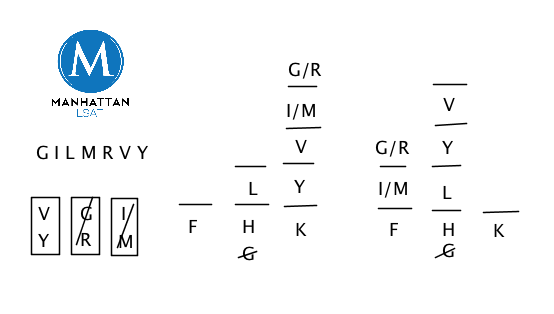Hey guys, got another question for you!
I was wondering if there is a big deduction regarding game 3 about the film buffs that I may have missed. According to a TLS poster, this game with the right deduction should not take long at all, but I found myself spending ages on it.
Here are the deduction I was able to make.
G will never watch H
K has either 1 viewer, or 4 viewers. (so V/Y must be at F or H)
If K has 1 viewer, then the distribution will be 4 H, 2 F
If K has 4 viewers, then the distribution will be 2 h, 1 F
Are there further inferences I could have made that would've made this less plug and chug and more educated guesses?
Thanks!
LSAT Forum
4 postsPage 1 of 1
-

- kiwistory
-
Thanks Received: 0
- Forum Guests
- Posts: 9
- Joined: June 28th, 2010
-

- ManhattanPrepLSAT1
-
Thanks Received: 1909
-
Atticus Finch

- Posts: 2851
- Joined: October 07th, 2009
- This post thanked 1 time.
Re: PT27, S2, G3 - Exactly seven film buffs
Your deductions sound great! Thinking about the numerical distributions is critical to solving these open grouping games. Remember, games like this won't always be so constrained.


-

- Aliyachisti9
-
Thanks Received: 0
-
Vinny Gambini

- Posts: 2
- Joined: September 19th, 2012
Re: Diagram
I was wondering if you could explain how you knew to make the classic films the base instead of the film buffs. In the manhattan logic games book the skills for open assignment highlight to have the larger number as the base and the smaller one as the assignments. How do I know when to place which as bases and which as assignments?
-

- timmydoeslsat
-
Thanks Received: 887
-
Atticus Finch

- Posts: 1136
- Joined: June 20th, 2011

- Most Thanked

- First Responder
Re: Diagram
Aliyachisti9 Wrote:I was wondering if you could explain how you knew to make the classic films the base instead of the film buffs. In the manhattan logic games book the skills for open assignment highlight to have the larger number as the base and the smaller one as the assignments. How do I know when to place which as bases and which as assignments?
The Manhattan approach calls for you to consider that numerical distributions play a role in how to setup the elements. In this game, we are given a huge numbers rule by being told that 2X H -F, and with only 7 elements, this breaks down to a situation of:
H-F-K
2-1-4
4-2-1
And now we have a block of VY and a bunch of variables that cannot go together. Anytime you have an opportunity to represent blocks, do so.
4 posts Page 1 of 1